Archived Article Detail
By Thomas P. Moore
WHAT’S NEW IN THE MINERAL WORLD ARCHIVE – posted on 3/3/2006
As I write this in early March, nearly all of the visitors to the 2006 Tucson Show have returned home, unpacked their specimens, calmed their nerves and caught up on sleep. My print report on the Show will appear, as usual, in the “What’s New in Minerals” column of the Mineralogical Record, and naturally that report will offer a lengthier, more detailed and better illustrated account of what was new there than the present column can or should do. But I will include here one or two viewing experiences from the Show, some early bulletins, and notes on new minerals recently seen both at the Show and on the web. “What’s new in minerals” tends at this time of year to become a diverse, widely ramified topic—the better to keep us alert, instructed and entertained.
The 2006 Tucson Show
One of the major sources of show-buzz this year was a new discovery (November-December 2005) of hundreds of very fine specimens of realgar in shaft #5, 280-meter level, Baia Sprie, Maramures, Romania. Notable realgar crystals, in most cases associated with stibnite crystals, have been found intermittently at this locality for decades, perhaps indeed for centuries: the mines of Felsöbánya (the old Hungarian name for Baia Sprie) are very old. The new specimens show very vividly red, sharp, blocky prisms of realgar, some hoppered and partly hollow, to 7 cm, in most cases resting on chalky white carbonate matrix with crystals and/or small masses of quartz, pyrite, and stibnite. Pierre Clavel, who purchased many of the specimens at a miner’s home on-site, reports that there are at least two generations of realgar crystals; he also reports his peak experience of cracking open a lump of massive realgar/stibnite and finding beautiful realgar crystals in a vug within. Many of the realgar specimens moved from Romania to France, and thence to the U.S. via several dealers, most prominently Chris Wright of Wright’s Rock Shop, who had the best selection at Tucson. Some specimens showed up on the Wright website (www.wrightsrockshop.com) before the Show, and other dealers, including Gobin Mineraux (Mineralsweb.com) and The Arkenstone (www.irocks.com) also previewed them; in Tucson these dealers, plus a couple of others, offered beautiful pieces. René Triebl’s short article on the discovery, with an underground picture of the pocket in question, appears in the January 2006 issue of Lapis. 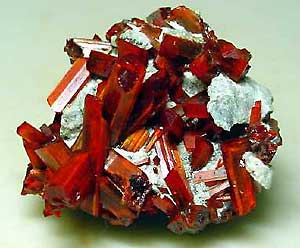
Much less commonly seen at Tucson than the realgars, though maybe even more exciting, were specimens showing very sharp, bright pink to rose-red crystals of rhodonite from another earlier-known (though thus far obscure) occurrence: a manganese-rich skarn deposit near Conselheiro Lafaiette, Minas Gerais, Brazil. Linus Keating of Arizona Lapidary & Gem Rough (www.SierraMadreTraders.com) is now laboring hard to master the difficult technology of extracting good rhodonite specimens from the hard, ornery skarn rock, consisting of admixed amphibole, spessartine, calcite, rhodonite, pyroxmangite, and Mn oxides: a few fine thumbnails and miniatures, and one absolutely world-beating specimen showing a lustrous, terminated, gemmy 2 x 3-cm rhodonite crystal in a 5.2-cm cluster, attest to his progress. Clearly this item falls into the wait-and-see category, but there are encouraging signs that the waiting will prove worthwhile.
Good numbers of specimens of pale blue and pale yellow barite, occurring as subparallel bundles of thin-platy, lustrous crystals to 5 cm rising from carbonate matrix, were found sometime in 2005 at Warihuyn, Miraflores Huamalias, Huanuco, Peru. But these Peruvian barites are not to be confused (although several ambiguous labels and vague verbal remarks overheard at Tucson did confuse them) with specimens from a discovery of barite made late last year in a quarry in the Prefecture of João Pessoa, in the state of Paraíba, near the easternmost tip of Brazil. In the Brazilian specimens the transparent, diamond-shaped barite crystals range in color (as do the Peruvian crystals) between pale blue and pale yellow; but the Brazilian crystals, reaching 4 cm across, are thicker, more individualized, and less lustrous than the Peruvian ones, and some are of a beautiful golden orange hue. The matrix in the Brazilian case is a tan-colored limestone, although most of the barite crystals and crystal clusters are “loose,” making splendid toenails and miniatures. These specimens come, apparently, from the same area (perhaps from the very same quarry) as the gray-blue barite rosette specimens from João Pessao which showed up in the early 1990’s (see vol. 22, no. 5, p. 387 and vol. 23, no. 3, p. 276). Some of the deep orange, transparent crystals show dark phantoms parallel to their edges.
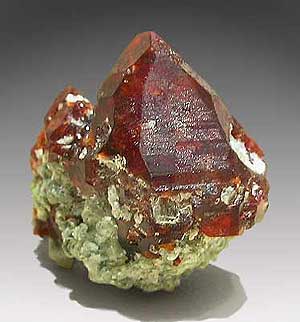 My report on the 2005 Denver Show mentioned the debut, at that show, of sharp, deep reddish brown, in some cases gemmy crystals of “chondrodite” to 1.5 cm or so, from Ladjuar Madan, Kokcha Valley, Badakhshan, Afghanistan; mostly the crystals come in loose, thumbnail-size clusters, or rest in flaky matrix of greenish white muscovite and/or talc. Had these indeed been chondrodite they would rival the classic specimens found long ago at the Tilly Foster mine, Brewster, New York. Well, several reliable investigators have recently shown the new crystals from Afghanistan to be, without a doubt, clinohumite. OK, we’ll call them the world’s best specimens of clinohumite, as they easily equal the gemmy orange crystals of that species which emerge very rarely from Tajikistan. At Tucson the chondrodite, beg pardon I mean the clinohumite, specimens were offered by several dealers; François Lietard and Dudley Blauwet, e.g., had perhaps a hundred apiece, the best specimens showing lustrous, lenticular, red-brown crystals to 2.5 cm. Before the Show, the website of John Veevaert (www.trinityminerals.com) also featured a few of the world-class clinohumites (then still called chondrodites) from this new and apparently flourishing locality.
My report on the 2005 Denver Show mentioned the debut, at that show, of sharp, deep reddish brown, in some cases gemmy crystals of “chondrodite” to 1.5 cm or so, from Ladjuar Madan, Kokcha Valley, Badakhshan, Afghanistan; mostly the crystals come in loose, thumbnail-size clusters, or rest in flaky matrix of greenish white muscovite and/or talc. Had these indeed been chondrodite they would rival the classic specimens found long ago at the Tilly Foster mine, Brewster, New York. Well, several reliable investigators have recently shown the new crystals from Afghanistan to be, without a doubt, clinohumite. OK, we’ll call them the world’s best specimens of clinohumite, as they easily equal the gemmy orange crystals of that species which emerge very rarely from Tajikistan. At Tucson the chondrodite, beg pardon I mean the clinohumite, specimens were offered by several dealers; François Lietard and Dudley Blauwet, e.g., had perhaps a hundred apiece, the best specimens showing lustrous, lenticular, red-brown crystals to 2.5 cm. Before the Show, the website of John Veevaert (www.trinityminerals.com) also featured a few of the world-class clinohumites (then still called chondrodites) from this new and apparently flourishing locality.
In the mid-2000’s there have been some refreshingly new finds of paravauxite and of the extremely rare sigloite in the Contacto vein area of the famous Siglo XX mine, Llallagua, Bolivia—long recognized as the world’s only source of good specimens of these minerals, as first noted by Samuel Gordon and Mark Chance Bandy in the 1920’s and 1930’s (see our upcoming March-April issue, containing a full article on Llallagua by Jaroslav Hyršl and Alfredo Petrov). At Tucson, specimens showing pale greenish white sprays and “pinwheels” of paravauxite to 3 cm and splintery yellow prismatic crystals of sigloite to 1 cm, both on matrix with microcrystals of other rare phosphate species, were offered by the young Kosnar brothers of Mineral Classics (www.Minclassics.com); another lot of specimens was offered before the show on the website (www.irocks.com) of indefatigable Rob Lavinsky.
Thumbnail-size but spectacular, electric blue sprays of thin-prismatic pentagonite crystals from the Wagholi quarry, Poona, India were fairy-dusted around the show; some sprays are themselves, in turn, dusted by tiny rhombohedrons of transparent yellow calcite. These amazingly colorful, nay psychedelic-looking, little items now seem to be coming quite liberally from “the cavansite place,” and several dealers at Tucson had them, though probably it is K.C. Pandey of Superb Minerals India (info@superbminerals.com) who had the most and the nicest.
From China, there is an increasingly swelling supply of the loose, lustrous, chocolate-brown, tabular crystals of vesuvianite which are now being seriously gathered for the collector market (about time!) from a skarn which fringes the Fushan iron mine, Han Dan area, Xintai city, Hebei Province. And bournonite specimens from the Yaogangxian mine, Hunan Province were everywhere at Tucson, with Chinese and Western dealers alike; most are thumbnail and miniature-size, and nearly all, unfortunately, show significant chipping—but the great, unchipped, 10.5-cm crystal shown on the cover of our Sept.-Oct. 2005 issue was also on hand, displayed proudly at the Main Show by private collector Marc P. Weill, and this tremendous beast marks the standard to which Yaogangxian bournonites may hereafter aspire.
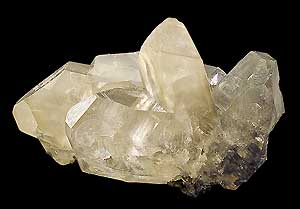 Very sharp, yellow-brown helvite crystals to 1.5 cm are now emerging from the Tongbei, Fujian Province locality for spessartine/smoky quartz/orthoclase—some of these may be seen on a new Chinese dealer’s website, www.china-mineral.cn. And on the site of top-end dealer Stuart Wilensky (www.wilenskyminerals.com), you may see a picture (also shown here) of an extraordinary cerussite specimen found more than a year ago at the Daoping mine near Guilin, Guangxi Province—yes, the great pyromorphite locality of the late 1990’s. The cerussite specimen is a lustrous, transparent and colorless, mirror-faced cyclic twin measuring 6.25 cm wide: altogether unlike, and radically better than, the specimens showing yellowish, much smaller cerussite crystals which were found sparsely when the fine pyromorphites were dug (see the article on the Daoping mine in Jan.-Feb. 2005). When I saw this specimen at the show it was already spoken for, but let’s hold on to its image, in case more such wonderful Tsumeb-like cerussite specimens come from China someday.
Very sharp, yellow-brown helvite crystals to 1.5 cm are now emerging from the Tongbei, Fujian Province locality for spessartine/smoky quartz/orthoclase—some of these may be seen on a new Chinese dealer’s website, www.china-mineral.cn. And on the site of top-end dealer Stuart Wilensky (www.wilenskyminerals.com), you may see a picture (also shown here) of an extraordinary cerussite specimen found more than a year ago at the Daoping mine near Guilin, Guangxi Province—yes, the great pyromorphite locality of the late 1990’s. The cerussite specimen is a lustrous, transparent and colorless, mirror-faced cyclic twin measuring 6.25 cm wide: altogether unlike, and radically better than, the specimens showing yellowish, much smaller cerussite crystals which were found sparsely when the fine pyromorphites were dug (see the article on the Daoping mine in Jan.-Feb. 2005). When I saw this specimen at the show it was already spoken for, but let’s hold on to its image, in case more such wonderful Tsumeb-like cerussite specimens come from China someday.
From the Web
At last year’s Munich Show, Rob Lavinsky managed to score some highly unusual and attractive specimens of colemanite from Turkey (see Wendell Wilson’s Munich report in Jan.-Feb. 2006). In Tucson, Rob had only a few leftovers from that lot, as between the two shows he had marketed all of the specimens on his website (www.irocks.com), and, being a rich, bright yellowish brown, they are highly noteworthy, especially considering colemanite’s usual flat-boring whiteness. Rob’s specimens are loose clusters of crystals, and blankets of crystals on massive colemanite matrix, between 3 and 7 cm across. The crystals themselves are lustrous, blocky twins reaching 2 cm, with a zoned coloration—brown to colorless—reflected by zoned fluorescence. The locality is a borate mine called (deep breath) the Mustafakemalpascha mine, in Western Anatolia Province, Turkey. 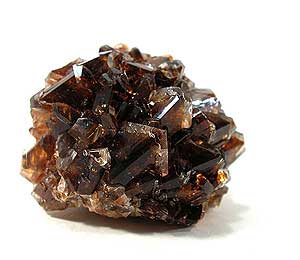
One of the “deepest” mineral websites out there right now is that of Marin Mineral Company (www.marinmineral.com), run by Mike Keim of Larkspur, California. Page after page of offerings take one to dozens of worldwide places to view nice minerals (most of them quite modestly priced), but naturally the “Tucson 2006 Minerals” section beckons most insistently. Within “Mixed Minerals” in that section, a few dramatic specimens from a new strike of scepter amethyst in the Kakamunurle mine, Tamil Nadu state, southern India, grabbed my attention: I’d seen a specimen clearly from the same find in a display case at the Main Show at Tucson, and the “Kakamunurle mine” had not been specified on the label (perhaps this new source lies near to, or is even identical with, the pegmatite locality at “Karur,” Tamil Nadu, which produced nice scepter amethyst in the late 1990’s?). In the Marin Minerals specimens, anyway, very sharp, equant, deep purple and gemmy scepter tips to 2 cm across perch on much thinner prisms of pale amethyst, with dark specks of something, perhaps hematite, visible as inclusions within the prisms. When the thin prism-stalks are connected at their bases, and the dark purple scepter heads lightly touch at the top, beautiful amethyst “bouquets” result.
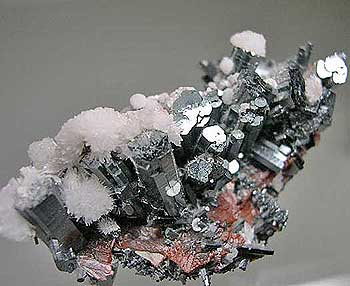 Under “Africa” in Mike Keim’s new Tucson pages, there appear a few dazzling specimens of a new style of hematite, reportedly from a single pocket opened very late in 2005 in the “N’Chwaning mine,” Kuruman manganese district, South Africa—here one speculates that the locality may be, not the long-known N’Chwaning I or N’Chwaning II mines, but a new shaft working called N’Chwaning III which already has produced specimens of attractive, pearly blue brucite, as noted in the last what’s-new-online. The hematite crystals are sharp, highly lustrous, simple hexagonal prisms with flat basal terminations, most of them about 2 cm long and less than 1 cm wide and thick—Mike made up the term “metallic black beryl” to evoke the crystals’ prismatic appearance, and that is indeed what they look like. Matrix pieces up to 10 cm across show the flashing prismatic crystals rising from massive hematite and brick-red andradite; a later deposition of calcite forms white sprays on the tops of some of the hematite prisms. Let us pray to the Zulu deities that more pockets with hematite crystals of this remarkable habit will be discovered.
Under “Africa” in Mike Keim’s new Tucson pages, there appear a few dazzling specimens of a new style of hematite, reportedly from a single pocket opened very late in 2005 in the “N’Chwaning mine,” Kuruman manganese district, South Africa—here one speculates that the locality may be, not the long-known N’Chwaning I or N’Chwaning II mines, but a new shaft working called N’Chwaning III which already has produced specimens of attractive, pearly blue brucite, as noted in the last what’s-new-online. The hematite crystals are sharp, highly lustrous, simple hexagonal prisms with flat basal terminations, most of them about 2 cm long and less than 1 cm wide and thick—Mike made up the term “metallic black beryl” to evoke the crystals’ prismatic appearance, and that is indeed what they look like. Matrix pieces up to 10 cm across show the flashing prismatic crystals rising from massive hematite and brick-red andradite; a later deposition of calcite forms white sprays on the tops of some of the hematite prisms. Let us pray to the Zulu deities that more pockets with hematite crystals of this remarkable habit will be discovered.
Also offered by Mike Keim (and by a few other dealers, both on the web and at Tucson) were some specimens showing beautiful yellow, gemmy hexagonal-prismatic crystals in clusters from thumbnail to small-cabinet size, these reportedly found in spring 2005 at the famous Wessels mine in the Kuruman, South Africa manganese-mining district; a few hundred specimens were initially brought out by Clive Queit. The yellow crystals were called ettringite at first but have since been identified as thaumasite, making these the first major Kuruman thaumasite specimens to have appeared since the wonderful pocket discovery of 1987 in the N’Chwaning II mine. Individual thaumasite crystals on these new specimens reach 2 cm, and the 4 x 4 x 7-cm cluster shown here (a Rob Lavinsky specimen) is one of the best known representatives of the find. 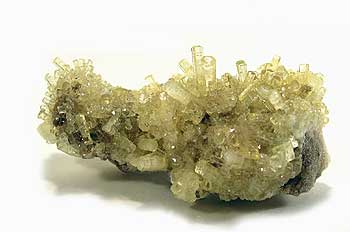
A small number of fine gold specimens from an unspecified locality in El Oro Province, Ecuador appeared at the 2005 Denver Show, and more have now shown up on John Veevaert’s website (www.trinityminerals.com). Lustrous yellow “filigrees” composed of microcrystals of gold have been exposed from enclosing quartz by acid-etching, and some aggregates rise freely from cavernous areas in the quartz or lie very lightly attached, making for very attractive matrix specimens, mostly of miniature size. In some specimens the gold crystals are tiny spinel-law twins, or tiny “leaves” with trigon faces visible under slight magnification.
John Veevaert’s Trinity Minerals website is in fact one of the “deepest” of all, as well as one of the oldest, going back to the pioneering days of mineral-selling online, i.e. back about ten years; the site by now has also become known for offering John’s well-illustrated reports on the Tucson, Denver, Munich and Ste-Marie-aux-Mines shows. Wandering in the site’s labyrinth leads one nowadays to some pretty specimens of andradite, epidote and diopside from “a new find near Jalalabad, Afghanistan.” Now Jalalabad is a town in northeastern Afghanistan, very near the border with Pakistan’s “Tribal Areas”—the whole region is a mountainous wilderness, not only of Taliban and Al Queida activity but also of casual little mineral digs, such that locality designations invariably are loose, vague, and confusing. John’s new andradite/epidote/diopside specimens come quite obviously from the same place(s) that produced the specimens which appeared in Germany in 1989 (see vol. 20, no. 6, p. 485, and vol. 21, no. 5, p. 486), at which time about five different localities, both in Afghanistan and Pakistan, were being given by dealers; thus “near Jalalabad” is probably as good a term to put on your labels as any. It’s nice, anyway, to see the material visiting once again, for these are superb specimens of the three common species. The andradite comes as pale brown to deep greenish brown, very sharp, lustrous dodecahedral crystals, commonly to 2 cm and exceptionally to 5 cm, on drusy epidote. In those specimens wherein epidote dominates, the crystals are super-sharp, glassy, translucent to transparent, yellow-green to blackish green short prisms to 2 cm. In specimens starring diopside we see lustrous, pine-green, bladed to prismatic crystals to more than 1 cm on drusy clinochlore. Octahedral magnetite crystals to 1 cm are associated on some specimens too.
Another site mentioned before in this space, and well worth keeping up with, is that of Edelweiss Minerals (www.edelweissminerals.com), run from Spain by expert field collector Felix García García. Post-Tucson, Felix has put on the site some pretty new Portuguese specimens of fluorapatite, rather different from those cited last time; but it is a superb October 2005 find of autunite in north-central Portugal which is highlighted here. The locality is the Nossa Senhora do Assunçao mine, Aldeia Nova, near Ferreira de Aves, Viseu district—actually not a “mine” but a pegmatite quarry which has produced commercial feldspar and quartz since about 1990. Late in September 2004, Alfred Kugler of Austria took out about 300 extremely bright specimens showing thin-platy, yellow-green autunite crystals to 1 cm on edge carpeting gray quartz matrix pieces; these specimens were offered during the following month’s Munich Show (see vol. 36, no. 1, p. 118). But the 2004 specimens were eclipsed utterly by those found in an old collapsed adit in a brecciated zone of the quarry in October 2005: brilliant specimens composed entirely of loosely intergrown autunite crystal sheaves individually reaching 1.5 cm long, the delicate, loose crusts reaching 10 cm; these specimens resemble and rival the better-known ones of the Daybreak mine, Washington and of the Streuberg quarry, Vogtland, Germany. As in these earlier occurrences, the autunite (and/or uranocircite) crystals are so intensely fluorescent that they glow vividly even in sunlight. 
A last paragraph “from the Web” will touch on just a few more offerings, chosen for miscellaneous interest. Late in fall 2005, Lehigh Minerals (www.lehighminerals.com) offered a few superb thumbnails of veszelyite from the world’s only locality for good crystals of this very rare and beautiful Cu-Zn phosphate: the long-gone occurrence in the Black Pine mine, Philipsburg, Granite County, Montana (see the article in vol. 23, no. 6). Midnight-blue, wedge-shaped veszelyite crystals to 1 cm compose lovely clusters, loose and on matrix. The same site also has thumbnails of pseudomalachite and of philipsburgite from the Black Pine mine, the latter species as bright green masses of microcrystals on quartz. Mineral Classics (www.minclassics.com) offers rarities from Madagascar, including gray crystals of schiavinatoite to 5 mm on matrix with red tourmaline from the Ampanodiana pegmatite near Tetezantsio village, Antananarivo Province; also shown on this site are fine specimens of rhodizite, londonite and liddicoatite from the classic Madagascar pegmatites. Minerals Village (www.Mineralsvillage.com) has Italian specimens just obtained from the collection of Rossano Carlini of Rome. Most notable here are fine specimens of aragonite from the Giumentaro mine, Sicily (closed in 1984), but there are also classic items from Tuscany, Sardinia, and the Mt. Vesuvius lava fields, and there are non-colorful but fine-for-the-species talc specimens from Gabbro (no, not a rock type; a village), near Livorno, Tuscany. In these last-named specimens, dark green to brown, globular aggregates of microcrystals of talc form coatings on matrix.
News Items
Shane Dohnt of Australia runs a website whose address is www.redleadmine.com, and this is hardly surprising, as he is the current leaseholder for the Red Lead mine, adjacent to the Adelaide mine, in Tasmania; Shane mentions in his e-mail to me that the great crocoite specimens shown on the front and back covers of the Australia! issue of the Mineralogical Record (vol. 19, no. 6) both came from the Red Lead mine. Around March of this year, Shane will begin some serious underground work in the Red Lead, where mining a few years ago resulted in a new strike of fine crocoite specimens in an area that proved to correspond to the original Dundas Extended mine, where crocoite was first found around 1890. The old collapsed shaft has been dug out now, and the plan is to mine beyond it, into a totally oxidized zone of the orebody where the crocoite crystals, if found, will rest on black matrix of iron and manganese oxides. Shane Dohnt holds the lease also for the old Kapi mine, which once exploited an oxidized Pb-Cu-Zn deposit and yielded good specimens of crocoite, dundasite, and other secondaries, as well as magnificent yellow crystal groups of chromian cerussite. Shane intends soon to mine for specimens in the Kapi, for, he says, “the deposit has not been well explored, and there is potential for new minerals.” Stay tuned, beginning around mid-2006, for news from Tasmania.
Another new specimen-mining project much closer to home (for most of us) is now going on in the Oatman mining district of Mohave County, Arizona. A few years ago the show scene was graced by numerous, mostly smallish, specimens of lovely mint-green fluorite in frosty octahedral crystals to 2 cm or so, with drusy milky quartz, from the Homestake mine in the Oatman district, these having been brought out through the exertions of Mark Hay and Dick Morris of Arizona Minerals. Lately, both of these veteran field collectors have been too busy with other imperatives in their lives to do very much more collecting, but the job has passed to Randy McIntosh (randymc@npgcable.co) and Mike Van Straten, who have been coming up with Oatman fluorite specimens of a new and intriguing style. Some of the frosty octahedral crystals are, as before, pale green, but others are deep purple, and still others are color-zoned, with purple cores and green outer zones; in a few cases, little dodecahedral crystals of green fluorite have grown on the points of the octahedrons, so that the two-generational crystals have odd burr-like shapes. Under the straight-talking dealership name of Stope & Hope Minerals, Randy and Mike have been selling these specimens at some local shows in the West, but possibly, if more are found, the specimens will be appearing soon, too, in wider venues.
A splendid new site in the Cyberkingdom, run by Simon Camm of the Cambourne School of Mines, Cornwall, England, is one that I highly recommend to your attentions, especially if you like classic European localities (or especially, of course, if you’re English). Go to www.projects.ex.ac.uk/geomincentre and you’ll find a “Virtual Museum” of the Cambourne School of Mines, with pictures of old Cornish mineral specimens from the School’s collection, pictures of old Cornish mines and landscapes, and much information on the geology, history and culture of Cornwall. Viewing this site makes a nice complement to perusing the superb book Minerals of Cornwall and Devon (1987) by P.G. Embrey and R.F. Symes (available through the Mineralogical Record bookstore).
To conclude, I will place on the Early News the information that Marty Zinn’s Tucson “hotel show” will feature somewhat different arrangements in 2007. The Smuggler’s Inn will be no more (as a show venue); replacing it, and holding at least 60 dealers old and new, will be the Quality Inn-Benson Highway, one block from I-10 exit #262 at Benson Highway and Park Avenue—this is just a short distance from the Tucson Electric Park show and other shows near Palo Verde. Marty hopes and expects that, together with the InnSuites, Clarion and Ramada hotels, which will be as they have been, this new site will help the Arizona Mineral and Fossil Show to attract a record number of visitors, and thus enhance the general Tucson Experience for all.
May readers of this feature also enjoy all manner of Enhanced Experiences, until we “meet” again.
For questions about this column, please email Tom Moore.
